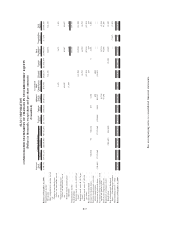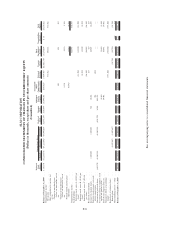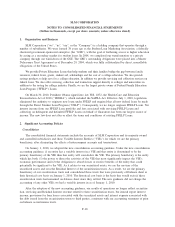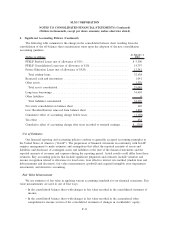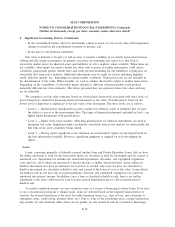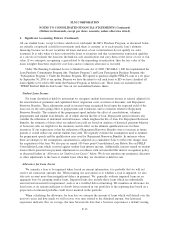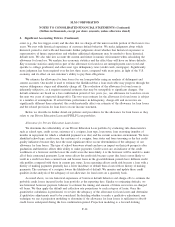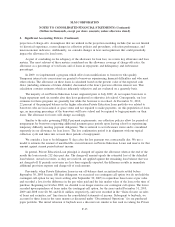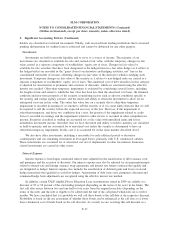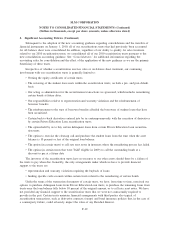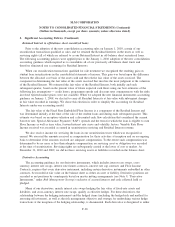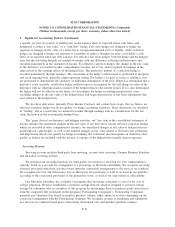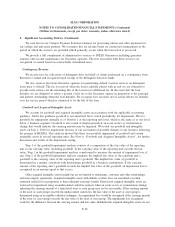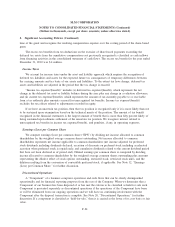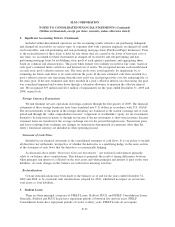Sallie Mae 2010 Annual Report Download - page 118
Download and view the complete annual report
Please find page 118 of the 2010 Sallie Mae annual report below. You can navigate through the pages in the report by either clicking on the pages listed below, or by using the keyword search tool below to find specific information within the annual report.2. Significant Accounting Policies (Continued)
projection of charge-offs. Assumptions that are utilized in the projection modeling include (but are not limited
to) historical experience, recent changes in collection policies and procedures, collection performance, and
macroeconomic indicators. Additionally, we consider changes in laws and regulations that could potentially
impact the allowance for loan losses.
As part of concluding on the adequacy of the allowance for loan loss, we review key allowance and loan
metrics. The most relevant of these metrics considered are the allowance coverage of charge-offs ratio; the
allowance as a percentage of total loans and of loans in repayment; and delinquency and forbearance
percentages.
In 2009, we implemented a program which offers loan modifications to borrowers who qualify.
Temporary interest rate concessions are granted to borrowers experiencing financial difficulties and who meet
other criteria. The allowance on these loans is calculated based on the present value of the expected cash
flows (including estimates of future defaults) discounted at the loan’s previous effective interest rate. This
calculation contains estimates which are inherently subjective and are evaluated on a quarterly basis.
The majority of our Private Education Loans originated prior to July 2009, do not require borrowers to
begin repayment until six months after they have graduated or otherwise left school. Consequently, our loss
estimates for these programs are generally low while the borrower is in school. At December 31, 2010,
22 percent of the principal balance in the higher education Private Education Loan portfolio was related to
borrowers who are in in-school or grace status and not required to make payments. As this population of loans
age, an increasing percentage of the borrowers will leave school and be required to begin payments on their
loans. The allowance for losses will change accordingly.
Similar to the rules governing FFELP payment requirements, our collection policies allow for periods of
nonpayment for borrowers requesting additional payment grace periods upon leaving school or experiencing
temporary difficulty meeting payment obligations. This is referred to as forbearance status and is considered
separately in our allowance for loan losses. The loss confirmation period is in alignment with our typical
collection cycle and takes into account these periods of nonpayment.
We consider a loan to be delinquent 31 days after the last payment was contractually due. We use a
model to estimate the amount of uncollectible accrued interest on Private Education Loans and reserve for that
amount against current period interest income.
In general, Private Education Loan principal is charged off against the allowance when at the end of the
month the loan exceeds 212 days past due. The charge-off amount equals the estimated loss of the defaulted
loan balance. Actual recoveries, as they are received, are applied against the remaining loan balance that was
not charged-off. If periodic recoveries are less than originally expected, the difference results in immediate
additional provision expense and charge-off of such amount.
Previously, when Private Education Loans in our off-balance sheet securitized trusts settled before
September 30, 2005 became 180 days delinquent, we exercised our contingent call option (we do not hold the
contingent call option for any trusts settling after September 30, 2005) to repurchase these loans at par value
and recorded a loss for the difference in the par value paid and the fair market value of the loan at the time of
purchase. Beginning in October 2008, we decided to no longer exercise our contingent call option. The losses
recorded upon repurchase of loans under the contingent call option, for the years ended December 31, 2010,
2009 and 2008 were $0, $0, and $141 million, respectively, and were recorded in the “Gains (losses) on sales
of loans and securities, net” line item in the consolidated statements of income. Subsequent to buyback, we
account for these loans in the same manner as discussed under “Discontinued Operations” for our purchased
paper portfolio. The initial valuation at buyback uses a discount rate similar to that used in valuing the Private
F-15
SLM CORPORATION
NOTES TO CONSOLIDATED FINANCIAL STATEMENTS (Continued)
(Dollars in thousands, except per share amounts, unless otherwise stated)




